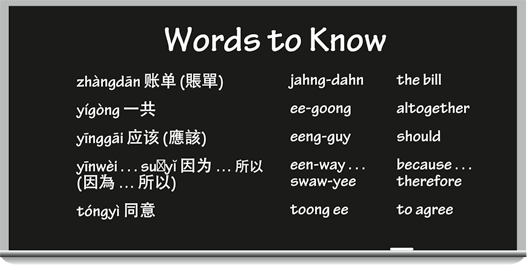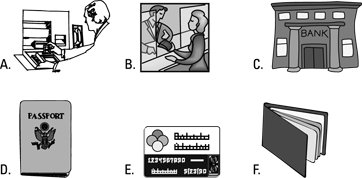Chinese For Dummies (108 page)
Read Chinese For Dummies Online
Authors: Wendy Abraham
 Tipping in mainland China used to be rare, but the idea is finally catching on, especially now that service with a scowl rather than a smile is fast becoming a thing of the past. (For the longest time, workers simply had no incentive to work harder or with a more pleasant demeanor after the Cultural Revolution. Can you blame workers for having no reason to perform their duties with the idea of customer service in mind?) A 3-percent tip is standard in restaurants (still low compared to Taiwan and Hong Kong). Bellboys and room service attendants typically expect a dollar or two (USD). Tipping in U.S. currency is still very much appreciated, because it's worth about six times as much as the Chinese dollar.
Tipping in mainland China used to be rare, but the idea is finally catching on, especially now that service with a scowl rather than a smile is fast becoming a thing of the past. (For the longest time, workers simply had no incentive to work harder or with a more pleasant demeanor after the Cultural Revolution. Can you blame workers for having no reason to perform their duties with the idea of customer service in mind?) A 3-percent tip is standard in restaurants (still low compared to Taiwan and Hong Kong). Bellboys and room service attendants typically expect a dollar or two (USD). Tipping in U.S. currency is still very much appreciated, because it's worth about six times as much as the Chinese dollar.
If you get a bill and can't make heads or tails of it, you can always ask the following question to find out whether the tip is included:
Zhà ngdÄn bÄokuò fúwùfÄi ma?
è´¦åå
æ¬æå¡è´¹å
?
(
賬å®å
æ¬æåè²»å
?)
(jahng-dahn baow-kwaw foo-woo-fay mah?) (
Does the bill include a service charge/tip?
)
 In English, when you say
In English, when you say
15 percent,
you mean 15 percent out of a total of 100. The way to express
bÇifÄnbÇ
ç¾åæ¯
(bye-fun-bee) (
percentages
) in Chinese is to start with the larger denomination of
bÇi
ç¾
(bye) (
100
) first and then work your way backward with the percentage of that amount. Here are some examples:
bÇifÄn zhÄ« bÇi
ç¾åä¹ç¾
(bye-fun jir bye) (
100 percent
[Literally:
100 out of 100 parts
])
bÇifÄn zhÄ« bÄshÃwÇ
ç¾åä¹å
«åäº
(bye-fun jir bah-shir-woo) (
85 percent
[Literally:
85 out of 100 parts
])
bÇifÄn zhÄ« shÃwÇ
ç¾åä¹åäº
(bye-fun jir shir-woo) (
15 percent
[Literally:
15 out of 100 parts
])
bÇifÄn zhÄ« sÄn
ç¾åä¹ä¸
(bye-fun jir sahn) (
3 percent
[Literally:
3 out of 100 parts
])
bÇifÄn zhÄ« lÃng diÇn sÄn
ç¾åä¹é¶ç¹ä¸
(
ç¾ååªé¶é»ä¸
)
(bye-fun jir leeng dyan sahn) (
0.3 percent
[Literally:
0.3 out of 100 parts
])
For more information on numbers, head to
Chapter 5
.
Talkin' the Talk
Ben and Erin are in a restaurant. They get their bill and discuss how much of a tip to leave.
Erin:
WÇmen de zhà ngdÄn yÃgòng sÄnshà kuà i qián. XiÇo fèi yÄ«nggÄi
duÅshÇo?
waw-men duh jahng-dahn ee-goong sahn-shir kwye chyan. shyaow fay eeng-guy dwaw-shaow?
Our bill comes to $30 altogether. How much should the tip be?
Ben:
YÄ«nwèi fúwù hÄn hÇo, suÇyÇ xiÇo fèi kÄyÇ bÇifÄn zhÄ« èr shÃ. NÇ tóngyì ma?
een-way foo-woo hun how, swaw-yee shyaow fay kuh-yee bai-fun jir are shir. nee toong-ee mah?
Because the service was really good, I think we can leave a 20-percent tip. Do you agree?
Erin:
Tóngyì.
toong-ee.
I agree.

 Â Fun & Games
 Fun & Games
Identify what the following illustrations depict in Chinese. See
Appendix D
for the correct answers.

A. ______________
B. ______________
C. ______________
D. ______________
E. ______________
F. ______________
Chapter 16
Getting Around
In This Chapter
 Traveling by plane
Traveling by plane
 Breezing through customs
Breezing through customs
 Shuttling around town
Shuttling around town
T
raveling halfway around the world to
ZhÅngguó
ä¸å½
(
ä¸å
)
(joong-gwaw) (
China
) can be a long haul. Knowing the magic traveling words and phrases in Chinese can make your journey as efficient and comfortable as possible. This chapter helps you make your way around the airport and the airplane, survive the customs experience, and board different types of transportation after you reach your destination.
Flying Around the Airport
Consider yourself a veteran traveler just because you've been all through Europe and the Americas? Well, my friend, you're in for a rude awakening. When it comes to finding your way around China, English (or any other Western language) does you little good. You spend a lot of unproductive time trying to interpret the signs to get some sense of which line to stand in and where to go next at the
fÄijÄ«chÇng
é£æºåº
(
é£æ©å ´
) (fay-jee-chahng) (
airport
). You need to at least know the
pīnyīn
æ¼é³
(pin-yin) (Literally:
spelled the way it sounds
) Romanization system, if not Chinese characters themselves. If you don't, you'll be up a creek without a paddle. You may end up following the guy next to you, even if it takes you to the bathroom rather than baggage claims. (See
Chapter 1
for more about the
pīnyīn
system of spelling Chinese words.)
Good move to get a head start by reading
Chinese For Dummies
in advance of your trip. You can bone up on some essential words and phrases before the whole airport experience makes you want to get right back on the next plane bound for home.
Making it past the check-in counter
Ready to
bà nlÇ dÄngjÄ« shÇuxù
åçç»è®°æç»
(
辦çç»è¨æçº
) (bahn-lee duhng-jee show-shyew) (
check in
)? After lugging your bags up to this point, you finally get to
tuÅyùn
æè¿
(
æé
) (twaw-yewn) (
check
) your
xÃnglÇ
è¡æ
(sheeng-lee) (
luggage
). You receive a
dÄngjÄ«pái
ç»æºç
(
ç»æ©ç
) (duhng-jee-pye) (
boarding pass
) at the check-in counter, at which point you're ready to make your way to the appropriate
chÅ«kÇu
åºå£
(choo-ko) (
gate
), taking only your
shÇutà xÃnglÇ
ææè¡æ
(show-tee sheeng-lee) (
carry-on luggage
).
All sorts of questions may be running through your mind about now. Here are some basic phrases that may come in handy during check-in:
 FÄijÄ« jÇ diÇn qÇfÄi?
FÄijÄ« jÇ diÇn qÇfÄi?
é£æºå ç¹èµ·é£
? (
é£æ©å¹¾é»èµ·é£
?) (fay-jee jee dyan chee-fay?) (
What time does it depart?
)
 WÇde hángbÄn hà omÇ shì duÅshÇo?
WÇde hángbÄn hà omÇ shì duÅshÇo?
æçèªçå·ç æ¯å¤å°
? (
æçèªçè碼æ¯å¤å°
?) (waw-duh hahng-bahn how-mah shir dwaw-shaow?) (
What's my flight number?
)
 WÇ xiÇng tuÅyùn xÃngli.
WÇ xiÇng tuÅyùn xÃngli.
ææ³æè¿è¡æ
. (
æé¦æéè¡æ
.) (waw shyahng twaw-yewn sheeng-lee.) (
I'd like to check my luggage.
)
 WÇ xiÇng yà o kà o chuÄng de wèizi.
WÇ xiÇng yà o kà o chuÄng de wèizi.
ææ³è¦é çªçä½å
. (waw shyahng yaow cow chwahng duh way-dzuh.) (
I'd like a window seat.
)
 WÇ xiÇng yà o kà o guòdà o de wèizi.
WÇ xiÇng yà o kà o guòdà o de wèizi.
ææ³è¦é è¿éçä½å
. (
ææ³è¦é ééçä½å
.) (waw shyahng yaow cow gwaw-daow duh way-dzuh.) (
I'd like an aisle seat.
)
 Zà i jÇ hà o mén hòujÄ«?
Zà i jÇ hà o mén hòujÄ«?
å¨å å·é¨åæº
? (
å¨å¹¾èéåæ©
?)
(dzye jee how mun ho-jee?) (
Which gate do we leave from?
)
 Zhè shì wÅde hùzhà o.
Zhè shì wÅde hùzhà o.
è¿æ¯æçæ¤ç
§
. (
éæ¯æçè·ç
§
.) (jay shir waw-duh hoo-jaow.) (
Here's my passport.
)